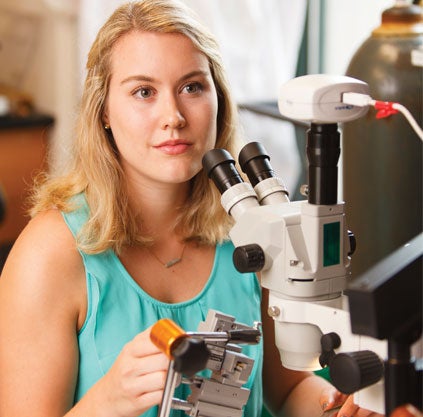 Everyone talks about the bee’s knees, but what about its compound eyes? That’s what biology major Anna Collett cares about when she’s studying the European honeybee in professor Jason Vance’s lab at the College’s Harbor Walk campus on the Charleston Harbor.
Everyone talks about the bee’s knees, but what about its compound eyes? That’s what biology major Anna Collett cares about when she’s studying the European honeybee in professor Jason Vance’s lab at the College’s Harbor Walk campus on the Charleston Harbor.
Collett and Vance are trying to better understand the visual system of honeybees, including their compound eyes (honeybees also have three simple eyes, called ocelli), and to what extent visual cues contribute to a bee’s ability to quickly change motion while in flight. Previous experiments have shown that bees are extremely reactive to certain sensations, such as a gust of wind, and can right themselves within a tenth of a second if they are blown sideways. But what role bees’ compound eyes play in the process has remained a mystery.
To accomplish this sleuthing work, Collett and Vance first prepare a bee for experimentation. Taking one of the insects from a Plexiglass case in the lab, Collett places it on a table and exposes it to a bit of carbon dioxide. The bee is soon sedated.
Next, using sandpaper, Collett shaves a small patch of the sleepy bee’s back between its wings. Then she applies a drop of superglue to the shaved area and attaches the bee to the head of a pin. In minutes, the glue dries and the bee awakens, resulting in a fully functional, but tethered, bee.
 No matter the considerable amount of practice Collett has had, it’s not easy to be a bee anesthetist and surgeon.
No matter the considerable amount of practice Collett has had, it’s not easy to be a bee anesthetist and surgeon.
“I started in November last year, and I’m still not an expert,” says Collett. “It depends on how wiggly they are. Sometimes they get a little feisty.”
With the bee firmly tethered, they suspend the insect in front of a panel of custom LEDs, or what Vance calls the “bee Jumbotron.” Indeed, the bee is essentially placed in front of a giant Imax screen of bright lights.
This accomplished, Collett can test the bee’s reactions to visual stimuli. When the LED screens simulate a pattern that make it seem as if the bee is falling, it will flap its wings quickly, 200 wingbeats a second on average, in an effort to prevent it from crashing to the ground (even though it is held firmly in place by the pin).
“In our experiments, we’re making the bee think it’s moving,” notes Vance. “We’re simulating egomotion – the perception of self-motion.”
Previously, the Office of Naval Research funded Vance’s work on bees’ visual systems and flight abilities, as the military is interested in how lightweight insects control flight and complicated aerial maneuvers. Vance explains that biologically inspired sensory systems could be very useful in applications like drones. The more scientists learn about flying insects’ visual systems, the better the chance engineers can implement those principles to control lightweight, small-scale flying platforms.
“Ultimately, the goal is to understand the limits of how bees use their visual systems for reactive flight control,” says Vance, who keeps an apiary in the backyard of his home on Johns Island.
For Collett, who has hopes of becoming a veterinarian, the research experience has been invaluable, giving her increased exposure to animal biomechanics, physiology and anatomy.
And, having studied honeybees so closely, she can now safely say: Compared to its eyes, the bee’s knees are grossly overrated.
Photos by Kip Bulwinkle ’04




